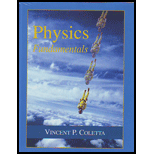
Concept explainers
(a)
The internal work-done by the athlete.
(a)
Answer to Problem 68P
400 Joules
Explanation of Solution
Given:
The center of mass of athlete moves 0.500 meters.
The muscular energy that needs to be spent on the athlete to lift his body is 800 N.
Formula Used:
The work-done by the internal energy is
Calculation:
800 N is basically the force that is needed to overcome by the gravity to jump upward.
Conclusion:
The work-done by the internal energy of jumper is 400 Joules.
(b)
The speed of the athlete.
(b)
Answer to Problem 68P
Explanation of Solution
Given:
The center of mass of athlete moves 0.500 meters.
The muscular energy that needs to be spent on the athlete to lift his body is 800 N.
Formula Used:
The potential energy is equal to the kinetic energy of the athlete
Calculation:
Considering
Conclusion:
The speed is
(c)
The time of jump for given height.
(c)
Answer to Problem 68P
The time required to reach 0.400 m height by the jumper will be 0.5145 sec.
Explanation of Solution
Given:
Initial speed,
Final speed,
Formula Used:
Calculation:
Negative sign shows the deceleration.
Now, the acceleration of the jumper is
Solving the equation, t will be -0.1174 seconds.or 0.5145 seconds. Negative time does not make any sense. Hence, the t will be 0.5145 seconds.
Conclusion:
The time required to reach 0.400 m height by the jumper will be 0.5145 s.
(d)
The average mechanical power.
(d)
Answer to Problem 68P
Explanation of Solution
Given:
Initial speed,
Final speed,
Formula Used:
Calculation:
Negative sign shows the deceleration.
Now, the acceleration of the jumper is
As,
Conclusion:
The average power is 1265.822 Watts.
Want to see more full solutions like this?
Chapter 7 Solutions
Physics Fundamentals
- 1. An arrangement of three charges is shown below where q₁ = 1.6 × 10-19 C, q2 = -1.6×10-19 C, and q3 3.2 x 10-19 C. 2 cm Y 93 92 91 X 3 cm (a) Calculate the magnitude and direction of the net force on q₁. (b) Sketch the direction of the forces on qiarrow_forward(Figure 1)In each case let w be the weight of the suspended crate full of priceless art objects. The strut is uniform and also has weight w Find the direction of the force exerted on the strut by the pivot in the arrangement (a). Express your answer in degrees. Find the tension Tb in the cable in the arrangement (b). Express your answer in terms of w. Find the magnitude of the force exerted on the strut by the pivot in the arrangement (b). Express your answer in terms of w.arrow_forward(Figure 1)In each case let ww be the weight of the suspended crate full of priceless art objects. The strut is uniform and also has weight w. Find the direction of the force exerted on the strut by the pivot in the arrangement (b). Express your answer in degrees.arrow_forward
- A 70.0 cm, uniform, 40.0 N shelf is supported horizontally by two vertical wires attached to the sloping ceiling (Figure 1). A very small 20.0 N tool is placed on the shelf midway between the points where the wires are attached to it. Find the tension in the left-hand wire. Express your answer with the appropriate units.arrow_forwardFind the total bind Mev. binding energy for 13 Carbon, 6C (atomic mass = 13.0033554)arrow_forwardWhat is the 27 energy absorbed in this endothermic Auclear reaction 2] Al + 'n → 27 Mg + ! H? (The atom mass of "Al is 26.981539u. and that of 11 Mg is 26.984341u) MeVarrow_forward
- What is the energy released in this nuclear reaction 1 F + "', H-1 O+ He? 19 19 16 (The atomic mass of 1F is 18.998403 u, and that of 20 is 15.9949154) MeV.arrow_forwardWhat is the energy released in this B+ nuclear reaction خالد 2½ Al w/ Mg + ie? (The atomic mass of 11 Al is 23.9999394 and that > of 12 Mg is 23.985041 u) MeV.arrow_forwardWhat is the energy released / absorbed in this nuclear reaction 14 N+ & He → » O + ! N? (The atomic mass of 14 N is 14.003074u. 17N+ and that of 10 is 16.9991324). MeVarrow_forward
- Can someone help me answer this question thanks.arrow_forwardCan someone help me with this question thanks.arrow_forward4B. Four electrons are located on the corners of a square, one on each corner, with the sides of the square being 25 cm long. a) Draw a sketch of the scenario and use your sketch to b) Determine the total force (magnitude and direction) on one of the electrons from the other three?arrow_forward
 Classical Dynamics of Particles and SystemsPhysicsISBN:9780534408961Author:Stephen T. Thornton, Jerry B. MarionPublisher:Cengage Learning
Classical Dynamics of Particles and SystemsPhysicsISBN:9780534408961Author:Stephen T. Thornton, Jerry B. MarionPublisher:Cengage Learning Physics for Scientists and Engineers: Foundations...PhysicsISBN:9781133939146Author:Katz, Debora M.Publisher:Cengage Learning
Physics for Scientists and Engineers: Foundations...PhysicsISBN:9781133939146Author:Katz, Debora M.Publisher:Cengage Learning College PhysicsPhysicsISBN:9781285737027Author:Raymond A. Serway, Chris VuillePublisher:Cengage Learning
College PhysicsPhysicsISBN:9781285737027Author:Raymond A. Serway, Chris VuillePublisher:Cengage Learning University Physics Volume 1PhysicsISBN:9781938168277Author:William Moebs, Samuel J. Ling, Jeff SannyPublisher:OpenStax - Rice University
University Physics Volume 1PhysicsISBN:9781938168277Author:William Moebs, Samuel J. Ling, Jeff SannyPublisher:OpenStax - Rice University Principles of Physics: A Calculus-Based TextPhysicsISBN:9781133104261Author:Raymond A. Serway, John W. JewettPublisher:Cengage Learning
Principles of Physics: A Calculus-Based TextPhysicsISBN:9781133104261Author:Raymond A. Serway, John W. JewettPublisher:Cengage Learning Physics for Scientists and Engineers with Modern ...PhysicsISBN:9781337553292Author:Raymond A. Serway, John W. JewettPublisher:Cengage Learning
Physics for Scientists and Engineers with Modern ...PhysicsISBN:9781337553292Author:Raymond A. Serway, John W. JewettPublisher:Cengage Learning





